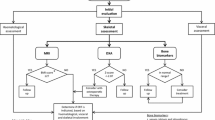Abstract
Summary: Mucolipidosis type III (ML III; McKusick 252600) is a rare lysosomal storage disease in which skeletal involvement is prominent, in particular the destruction of vertebral bodies and the femoral heads. We describe studies in two siblings with ML III that suggest the presence of a distinct metabolic bone disorder. Biochemical indices of bone turnover were increased, and transiliac bone biopsy demonstrated both trabecular osteopenia and marked subperiosteal bone resorption. Intravenous pamidronate treatment given monthly for a year was well tolerated and produced dramatic clinical effects, with reduction in bone pain and improvements in mobility, despite incomplete suppression of bone resorption as assessed by biochemical, radiographic and histological criteria. Bisphosphonate therapy may have an important role in the management of bone pain in ML III, as it does in the related lysosomal disorder of Gaucher disease.
Similar content being viewed by others
REFERENCES
Astrom E, Soderhall S (1998) Beneficial effect of bisphosphonate during five years of treatment of severe osteogenesis imperfecta. Acta Paediatr 87: 64–68.
Bassett CAL, Donath A, Macagno F, Preisig R, Fleisch H, Francis MD (1969) Diphosphonates in the treatment of myositis ossificans. Lancet ii: 845.
Baron R, Neff L, Brown W, Courtoy PJ, Louvard D, Farquhar MG (1988) Polarized secretion of lysosomal enzymes: co-distribution of cation-independent mannose-6–phosphate receptors and lysosomal enzymes along the exocytic pathway. J C ell Biol 106: 1863–1872.
Barriocanal JG, Bonifacino JS, Yuan L, Sandoval IV (1986) Biosynthesis, glycosylation, movement through the Golgi system, and transport to lysosomes by an N-linked carbohydrate-independent mechanism of three lysosomal integral membrane proteins. J Biol C hem 261: 16755–16763.
Brumsen C, Hamdy NA, Papapoulos SE (1997) Long-term effects of bisphosphonates on the growing skeleton. Studies of young patients with severe osteoporosis. Medicine 76: 266–283.
Chapurlat RD, Delmas PD, Liens D, Meunier PJ (1997) Long-term effects of intravenous pamidronate in fibrous dysplasia of bone. J Bone Miner Res 12: 1746–1752.
Cianna G, Cuttini M, Bembi B (1997) Short-term effects of pamidronate in patients with Gaucher's disease and severe skeletal involvement. N Engl J Med 337: 712.
Glorieux FH, Bishop NJ, Plotkin H, Chabot G, Lanoue G, Travers R (1998) Cyclic administration of pamidronate in children with severe osteogenesis imperfecta. N Engl J Med 339: 947–952.
Glorieux FH, Travers R, Taylor A, et al (2000) Normative data for iliac bone histomorphometry in growing children. Bone 26: 103–109.
Haddad FS, Hill RA, Vellodi A (2000) Orthopaedic manifestations of mucolipidosis type III: an illustrative case. J Pediatr Orthop 9: 58–61.
Harinck HI, Bijvoet OL, Van der Meer JW, Jones B, Onvlee GJ (1984) Regression of bone lesions in Gaucher's disease during treatment with aminohydroxypropylidene bisphosphonate. Lancet ii: 513.
Hetherington C, Harris NJ, Smith TWD (1999) Orthopaedic management in four cases of mucolipidosis type III. J R Soc Med 92: 244–246.
Kornfeld S, Sly WS (2001) I-cell disease and pseudo-Hurler polydystrophy: disorders of lysosomal enzyme phosphorylation and localization. In: Scriver CR, Beaudet AL, Sly WS, Valle D, eds; Childs B, Kinzler KW, Vogelstein B, assoc. eds. The Metabolic and Molecular Bases of Inherited Disease, 8th edn, vol III. New York: McGraw-Hill, 3469–3482.
Lala R, Matarazzo P, Bertelloni S, Buzi F, Rigon F, de Sanctis C (2000) Pamidronate treatment of bone fibrous dysplasia in nine children with McCune-Albright syndrome. Acta Paediatr 89: 188–193.
Landsmeer-Beker EA, Massa GG, Maaswinkel-Mooy PD, van de Kamp JJP, Papapoulos SE (1997) Treatment of osteogenesis imperfecta with the bisphosphonate olpadronate (dimethylaminohydroxypropylidene bisphosphonate). Eur J Pediatr 156: 792–794.
Maroteaux P, Lamy M (1996) La pseudo-polydystrophie de Hurler. Presse Med 74: 2889–2892.
Melhem R, Dorst JP, Scott CI, McKusick VA (1973) Roentgen findings in mucolipidosis III (pseudo-Hurler polydystrophy). Radiology 106: 153–160.
Ostlere L, Warner T, Meunier PJ, et al (1991) Treatment of type 1 Gaucher's disease affecting bone with aminohydroxypropylidene bisphosphonate (pamidronate) Q J Med 79: 503–515.
Pazzaglia UE, Beluffi G, Campbell JB, et al (1989) Mucolipidosis II: correlation between radiological features and histopathology of the bones. Pediatr Radiol 19: 406–413.
Reitman ML, Varki A, Kornfeld S (1981) Fibroblasts from patients with I-cell disease and pseudo-Hurler polydystrophy are deficient in uridine 50–diphosphate-N-acetylglucosamine: glycoprotein N-acetylglucoaminylphosphotransferase activity. J Clin Invest 67: 1574–1579.
Rogers MJ, Gordon S, Benford HL, et al (2000) Cellular and molecular mechanisms of action of bisphosphonates. Cancer 88 (supplement 12): 2961–2978.
Samuel R, Katz K, Papapoulos SE, Yosipovitch Z, Zaizov R, Leiberman UA (1994) Aminohydroxypropylidene bisphosphonate (APD) treatment improves the clinical skeletal manifestations of Gaucher's disease. Pediatrics 94: 385–389.
Shoemaker LR (1999) Expanding role of bisphosphonate therapy in children. J Pediatr 134: 264–267.
Tanner JM, Whitehouse RH, Cameron N, Marshall WA, Healy MJR, Goldstein H (1983) Assessment of Skeletal Maturity and Prediction of Adult Height, 2nd edn. London. Academic Press.
Wihlborg CEM, Babyn PS, Clarke JTR (2000) MRI appearances of hip abnormalities in mucolipidosis type III. Pediatr Radiol 30: 262–264.
Zacharin M, Cundy T (2000) Osteoporosis pseudoglioma syndrome: treatment of spinal osteoporosis with intravenous bisphosphonates. J Pediatr 137: 410–415.
Author information
Authors and Affiliations
Corresponding author
Rights and permissions
About this article
Cite this article
Robinson, C., Baker, N., Noble, J. et al. The osteodystrophy of mucolipidosis type III and the effects of intravenous pamidronate treatment. J Inherit Metab Dis 25, 681–693 (2003). https://doi.org/10.1023/A:1022935115323
Issue Date:
DOI: https://doi.org/10.1023/A:1022935115323




